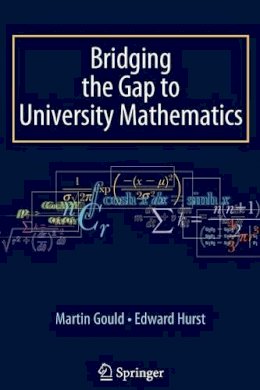
Stock image for illustration purposes only - book cover, edition or condition may vary.
Bridging the Gap to University Mathematics
Edward Hurst
FREE Delivery in Ireland
Description for Bridging the Gap to University Mathematics
Paperback. Written by students for students, this book offers a refreshing, new approach to making the transition into undergraduate-level mathematics or a similar numerate degree. The book contains chapters rich with worked examples and exercises. Num Pages: 344 pages, 24 black & white tables, biography. BIC Classification: PB. Category: (U) Tertiary Education (US: College); (UU) Undergraduate. Dimension: 235 x 177 x 18. Weight in Grams: 630.
Designed as an introduction to higher-education mathematics, Bridging the Gap is the only book of this sort written for students by students. The authors, Martin Gould and Edward Hurst, wrote this book as second-year undergraduates at Warwick University. Their experiences as students have helped them create an approachable and comprehensive introductory text that will be of benefit to anyone looking to make the step-up to university education. This book contains chapters rich with worked examples and exercises covering all the key subject-areas that a first-year undergraduate will encounter, such as Inequalities, Complex Numbers, Probability, Matrices and many more. The authors ... Read morehave also included a “Test Yourself” exercise at the beginning of each chapter so that students will know straightaway which chapters will be of most use to them. Every topic concludes with a “Where Now?” section that helps the reader find out exactly how and where they can apply their newly-learned skills.
Show Less
Product Details
Publisher
Springer London Ltd United Kingdom
Place of Publication
England, United Kingdom
Shipping Time
Usually ships in 4 to 8 working days
Reviews for Bridging the Gap to University Mathematics
From the reviews: “This book has been ‘written by students for students’. … the quite talkative style makes this book a pleasant ‘arm chair reading’ for freshmen and event teachers. … it can be recommended as an additional source for students in their first year calculus or linear algebra course.” (Jürgen Appell, zbMATH, Vol. 1271, 2013) “The authors ... Read moreof Bridging the Gap to University Mathematics, were students at a British university. … Their book consists of 20 independent chapters … including two on mechanics and two on differential equations. … Induction is done well, and there is material on logic and truth tables as well as on proof by contrapositive. … the book could be very useful to the beginning mathematics or engineering student–and even to the professor.” (James M. Cargal, UMAP Journal, Vol. 31 (1), 2010) "The book can be used also by … undergraduate students, graduate students (in their first years), high-school teachers, even mathematics faculty (to get ideas on making their courses more accessible to students). The book covers an array of twenty topics, from simple inequalities to series, and is easy to read, which makes it ideal for self-study. … It is an easy and entertaining read. … a good book to have for any student taking mathematics courses, as well as for any teacher teaching mathematics courses." (Mihaela Poplicher, The Mathematical Association of America, April, 2009) "Bridging the Gap to University Mathematics is intended to do exactly what the title suggests. Gould and Hurst were, at the time of writing, both students and one gets the feeling that their desire is to tell prospective students what they themselves wish someone had told them before they embarked on their own mathematical journey at university…The book covers a broad range of topics…Well written and easy to read, it divides the material into twenty chapters,which are broken down into manageable chunks. Every chapter begins with ten ’test yourself’ questions designed to help the student discover whether they really do understand a particular topic. As each one is written as a single entity, not depending on preceding content, it is a book that students can dip in and out of rather than read from cover to cover. It is pleasantly laid out and contains numerous worked examples which clearly illustrate the more complicated concepts. Each subsection is followed by an exercise for the students to work through to test their understanding. All answers, to these and the starter questions, are provided at the back of the book enabling students to monitor their progress. Concluding each chapter is a very helpful section entitled ’where now?’ which explains how this area of mathematics might come into their university course and where it could lead to. Readers are helpfully referred to other texts for further, more in-depth, material or interest. Lastly, an appendix provides useful formulae and extension questions, this time with worked solutions... The book is written in a fresh, conversational style that is neither patronising nor written in a format intended to solely appeal to the young. It is a book that one could quite easily use as the basis of an introductory or foundation course or to stretch the brightest sixth-formers with something interesting, possibly after they have taken their exams." (Noel-Ann Bradshaw, LMS, September 2010) Show Less

